|
To keep in theme with my past two blog posts which touched on processed and unprocessed foods, today we’ll be learning about different types of fats and why some fats have been deemed “good” or “bad.” In terms of calories, fat is fat – each gram of fat provides 9 calories. The chemical composition (saturated or unsaturated) of the fat is how we distinguish fats and determines what they do in our bodies. Along with lean protein and veggies, you should try to include fat from a healthy source at every meal, every day. One serving size of fat is one thumb for women and two thumbs for men.
Three types of fats are commonly found in the diet: saturated, monounsaturated, and polyunsaturated (omega-3 and omega-6). You will find these fats in processed and unprocessed foods. As you can guess, it is recommended that most of your dietary fat come from whole, unprocessed foods. Dr. John Berardi of Precision Nutrition recommends consuming a third of your total daily fat from each of these three types of fats: 1/3 saturated fat, 1/3 monounsaturated fat, 1/3 polyunsaturated fat (mostly omega-3). There are, of course, trans fats, which for the most part (with the exception of some meats and butterfat) do not occur in nature. For years saturated fat has been deemed “bad” by scientists and doctors, however it has recently been discovered that saturated fats aren’t all that “bad” – if they’re consumed as whole, natural (not man-made) foods. Saturated fats come from animal fats (meat, eggs, and dairy) as well as tropical oils like coconut, and these fats are solid at room temperature. Saturated fats are also found in TONS of processed foods, and that is when saturated fats become “bad.” I can’t say it enough – LIMIT PROCESSED FOODS! Monounsaturated fats are often referred to as “healthy” or “good” fats. This is because they help protect against heart disease, improve insulin sensitivity, improves mood, and strengthens bones. Monounsaturated fats can be found in nuts and nut butters, avocados, olives, and olive and peanut oils. When cooking with oils, it is important to be aware of their smoke points, as using very high heat with an oil that has a low smoke point will burn the oil, causing toxic compounds and, if it is an omega-3 oil, break down into trans fat. The best oils for cooking at high heat (heat-frying and stir-frying) are sesame and peanut, while olive oil is ideal for sautéing over medium heat. Polyunsaturated fats are found in most plant-based oils (soybean, corn) and some fish like salmon and albacore tuna. The majority of polyunsaturated fats consumed should be from omega-3 fats rather than omega-6 fats, as it has been discovered that too much omega-6 (a polyunsaturated fat) may be a contributor to coronary heart disease. While TOO MUCH omega-6 fats may cause health problems, we still need it in moderation. To sum it up, fats are, in fact, not bad – our brains and bodies need them! Healthy nutrition is always about moderation and eating whole, unprocessed foods when possible. If you’ve shied away from fats in the past, hopefully this blog post has made nutritional fat less scary for you! https://www.precisionnutrition.com/aa-bad-fats https://www.precisionnutrition.com/research-review-balancing-fats https://draxe.com/monounsaturated-fat/ #eatwholefood #eatrealfood #fats #healthyfats #moderation #wellness #nutrition #nutritioncoach #werresnutrition
1 Comment
This blog posts pulls from the idea from author Michael Pollan that we shouldn’t “eat anything that doesn’t rot,” and I couldn’t agree more. I touched on processed foods in a post from February 26, 2017, and, as Pollan also stated, it seems that most of the “foods” Americans are consuming are processed to some degree.
This post goes hand in hand with a recent blog post of mine about shopping the perimeter of the grocery store where I stated that the majority of unprocessed and minimally processed foods are located along the perimeter of the store. The idea of “if it doesn’t rot, don’t eat it” is similar to that of not eating foods that didn’t exist when our grandparents or great-grandparents were growing up. The premise of both suggestions is that whole, unprocessed foods such as fruits, vegetables, and meats will rot or spoil if not eaten over a period of time, even when refrigerated. In the past fats, cholesterol, salt, and sugar have all been blamed as culprits of chronic disease and obesity, and while full blame cannot be placed on any one substance, most or all of these “culprits” can be found in processed foods – and in high levels at that. While consuming too much of any one food, even healthy foods, can cause adverse side effects, processed foods quickly add up – meaning the average American would have to eat 7.5 bananas in one sitting to reach a dangerous level of potassium intake, while eating one can of chicken noodle soup almost meets the recommended daily allowance of sodium. The theory is that if we change our diets to only eat foods that don’t rot – foods that haven’t been processed at all or have been minimally processed – our health should improve because we will be consuming fewer preservatives, smaller amounts of “unhealthy” fats, less added sugar, and lower amounts of salt/sodium. You can’t really argue with this theory, and unlike dietary guidelines and suggestions that are conflicting and constantly changing, this theory holds true across the board. I know the idea of giving up processed foods can be scary, especially because processed foods provide us with quick meals and snacks. Meal planning and using crock pots and pressure cookers can be very beneficial in terms of preparing meals, and cleaning and chopping fresh fruits and vegetables to pair with a nut butter, a slice of cheese, or a handful of unsalted nuts make for a great snack. Another tasty, protein filled snack idea that is minimally processed is to make your own protein bars or balls. I made these lemon date balls about six months ago, and they made a great snack when I needed to run errands after the gym or needed a quick breakfast and hadn’t prepared anything. There are tons of recipes for protein bars/balls on Pinterest, or if you’re short on time like many of us are, I’ve found that Lara Bars and Thunderbird Bars (there are many more, but I’ve only tried these two brands) are made from real ingredients, are vegan, non-GMO, have no added sugar, and are a great option when you’re short on time. Eating “food that doesn’t rot” will not only decrease your intake of empty calories, preservatives, sugar, and salt, it will also increase your intake of fiber, healthy fats, antioxidants, vitamins, minerals, and other nutrients that our bodies need. Making the switch from processed to real foods is an adjustment and can take some time and getting used to. Start slowly, and don’t make it a huge focus – just remember that shopping the perimeter of the grocery store and cooking from scratch will be a huge help in the process. Think positive, stay active, and smile. -A https://www.alternet.org/story/76987/michael_pollan%3A_don%27t_eat_anything_that_doesn%27t_rot https://www.instagram.com/p/BUHlVhwFUPV/ #eatrealfood #mealprep #ifitdoesntrotdonteatit #nutrition #wellness #wholefood #werresnutrition #nutritioncoach Drinking enough water can be challenging for most people and can become even more of a challenge during the cooler months. When the outside temperature is cooler and we’re not sweating as much, we don’t feel “parched” or the need to drink as much water as we might when it is warmer outside.
Our hydration needs are dependent on our height and weight and change with age, activity level, and diet. Because there are so many factors that play into hydration needs, it can be hard to determine exactly how much water you need, but is important to have an idea of how much water is right for you. To determine this you can go online and use a “water calculator,” and there are many calculations you can find online as well. Here is one of the easier to use formulas I found: your weight in pounds x 2/3 (or 67%) = ounces of water you need per day for example: 120 pounds x .67 = 80.4 ounces (just over ten cups) of water per day This formula, from slenderkitchen.com, advises that for every 30 minutes you work out, you should add 12 ounces to your basic water needs. On Tuesdays and Thursdays, I work out intensely for an hour and a half, so according to this formula, on those days I should add 36 ounces to my total water intake. Using the above formula, I should be drinking 80 ounces of water a day when I don’t work out, but using two other formulas I found, I should be drinking between 60 to 68 ounces a day when I don’t work out. The only consistent information I’ve found is that for every 30 minutes you work out, you should add 12 ounces of water to your total daily intake. As you can see, there is some discrepancy with these calculations. You can typically tell if you need to drink more water by paying attention to your bathroom habits. If you are urinating infrequently and have dark colored urine, you are likely dehydrated. Although it is important that you stay hydrated, it is possible to drink TOO much water. If your urine is very pale yellow to clear throughout the day and you find yourself urinating frequently, you may need to cut back on your water intake. Some other telltale signs that you might be on the verge of dehydration are sleepiness, headache, dry mouth, dry skin, and dizziness. As previously mentioned hydration levels also depend on what you eat. Fruits and vegetables provide water as well as obvious foods like soup (although most soups contain high sodium levels which can dehydrate the body). And water isn’t the only liquid that hydrates – milk (both dairy and non-dairy) and caffeine-free beverages like decaf coffee and tea can also keep the body hydrated. Filling a large water bottle with room temperature water and setting it on your desk can help remind you to drink enough water during the winter days, and always make sure to take a bottle of water with you to your workout. Sipping a hot cup of decaf tea on a cold winter day is one of my favorite ways to try to stay hydrated during the winter. However you prefer to remain hydrated, make sure to be aware of possible signs of dehydration in yourself and those around you. Think positive, stay active, and smile. -A https://www.precisionnutrition.com/all-about-dehydration https://www.slenderkitchen.com/article/how-to-calculate-how-much-water-you-should-drink-a-day https://www.umsystem.edu/newscentral/totalrewards/2014/06/19/how-to-calculate-how-much-water-you-should-drink/ https://www.msn.com/en-gb/health/diet/how-much-water-you-should-drink-based-on-your-weight/ar-BBCS4y4 #nutrition #werresnutrition #water #drinkmorewater #hydration #nutritioncoach #wellness #healthylifestyle #healthyliving You may or may not have heard to “shop the perimeter of the grocery store,” and you may or may not know the reasoning as to why this is recommended. If you think about your local grocery store, you’ll notice that produce, the deli, meat, dairy, and frozen foods surround the center aisles of the store. You’ll also notice that these items are not processed to minimally processed foods, and this is why it is recommended to “shop the perimeter of the grocery store” first, saving the shopping for more processed foods for last. Typically a person who has already filled up their cart with healthier options is less likely to add a lot of unhealthy, highly processed food to their carts. If you’re sticking to a tight budget, it’s best to spend your money on foods that will nourish your body, and adding those foods to your cart first will save you from wasting your money on foods full of empty calories.
While this suggestion holds some truth – that most of the minimally process foods are found around the perimeter of the store – that doesn’t mean EVERYTHING found there is healthy, nor does it mean EVERYTHING that is found within the inner aisles is unhealthy. For example, lunch meat, hot dogs, and bacon are highly process foods that are located along the perimeter of the store, while dry and canned beans, canned fruit, and canned vegetables – minimally processed, healthy food options, are located within the center aisles. While grocery shopping, I would suggest shopping around the perimeter of the store first and using your best judgement when it comes to the choices you make. Choose minimally processed, locally grown, organic foods when possible. To better understand the various levels of the processing of foods, you can check out my blog post “What’s in a Bite – the Basics” from February 2017. Planning out meals for the week and making a list of what you’ll need, as well as avoiding grocery shopping while hungry, can also help you sidestep making unnecessary and possibly unhealthy purchases. I know a lot of people, myself included, hate grocery shopping, but planning out your trip and shopping the perimeter of the store will save you a lot of hassle. I know the grocery stores are quite daunting this time of year with the holidays quickly approaching, so good lunch, and Godspeed! Think positive, stay active, and smile. -A #healthyliving#healthylifestyle#nutritioncoach#werresnutrition#eatrealfood#nutrition#healthyeating Chances are you’ve heard or seen something about Himalayan salt lamps in social media, on TV, or from chatter from friends, but if you’re like me, you’re asking yourself, “Do these salt lamps REALLY work?” I’ve been wondering this myself, and recently a dear friend asked if I would do a blog post on the validity of said lamps – so here we are!
I’ve been doing a lot of research, and here’s what I’ve found. Himalayan salt lamps claim to purify air, reduce electromagnetic radiation and airborne infections, ease asthma and allergy symptoms, reduce anxiety and boost mood, and promote sleep. The lamps help purify air and ease asthma and allergy symptoms by attracting water molecules, trapping pollutants, and releasing water vapor back into the air. Salt therapy is now being used to treat COPD and is even being used in inhalers to help those with asthma and allergies. Salt lamps emit negative ions to combat positive ions released by cell phones, computers, and other electronic devices, reducing electromagnetic radiation and producing biochemical reactions that increase serotonin in the bloodstream helping to improve mood and increase energy. The natural properties from the salt and the glow from the lamp also provide a calm and happy atmosphere, boosting mood and decreasing anxiety. These claims all have very little evidence to back them up, and there has been little to no scientific research conducted on Himalayan salt lamps. If these lamps do provide said benefits, you’ll need more than one to get the job done. It is suggested to place a few lamps in the room in which you and/or your family spend the most time. If you choose to purchase a Himalayan salt lamp, be on the lookout for fakes. Dr. Axe advises to be on the lookout for poor return policy, a highly durable item, a very bright light, inexpensive white crystal, no mention of Pakistan (where true Himalayan salt is mined), and is listed as a moisture-resistant item. These all point towards a salt imposter, and unless it’s just a nightlight you’re after, you should keep shopping around to maximize the benefits from your lamp. I was gifted a salt lamp a couple of months ago and have been using it regularly. Because I know what these lamps are supposed to do, I’m not sure that I can provide an unbiased opinion on whether or not the lamp is doing what it claims to do. I turn the lamp on almost every afternoon that I’m home, and if I’m sitting right next to it, I do feel that it helps some with my allergies (less sneezing, sniffling, nose blowing). This could be a placebo effect, or perhaps my salt lamp really is purifying the air around me and trapping the pollutants and allergens. I have not noticed a change in my sleep habits or my mood. Whether or not you choose to believe that Himalayan salt lamps work, they certainly won’t hurt, as long as you use caution during use, as with any other lamp. At the very least, you’ll be able to enjoy the soft, warm glow of the lamp, will add to your home’s décor, and can provide a great conversation piece when friends and family visit! Think positive, stay active, and smile. –A. https://draxe.com/himalayan-salt-lamp/ https://www.livescience.com/59328-himalayan-salt-lamp-faq.html #wellness #blog #nutrition #blogger #nutritioncoach #werresnutrition #healthyeating #healthylifestyle #healthychoices #HimalayanSaltLamp Hey guys! I just made one of my favorite snacks, and I wanted to share it with you! Maybe you've made kale chips before, and if you have, you know how easy - and tasty - they are! The ingredients are simple enough - a bunch of kale, olive oil, sea salt, and any of your other favorite seasonings. Preheat the oven to 350°F, trim kale leaves from the stems, tear into small pieces, and wash and dry (in a salad spinner or pat dry). Line a cookie sheet with parchment paper, and spread kale evenly over pan. Coat kale evenly with about one tablespoon of olive oil (or coconut oil). I like to use a silicone baster to spread the olive oil evenly. Sprinkle with sea salt and/or any other seasoning(s) you love. I used sea salt and Cayenne pepper because I like it spicy! Once the oven is preheated, put the kale into the oven for 10-15 minutes. Pour yourself a glass of wine, and let your kale chips bake! I baked my chips for 15 minutes, which was a little too long, but 10 minutes wasn't long enough. I'd say shoot for 12-13 minutes, but every oven is different, so just keep an eye on your kale. Once you've removed the kale chips from the oven, let them cool for a minute or two before digging in! Enjoy!
We all know that getting enough sleep is important, but many of us don’t know why or how sleep is related to our overall health, including our weight. There is a long list of health complications which include but are not limited to:
So getting enough sleep is clearly important to protect ourselves and helps us stay healthy, but how can we ensure we’re getting enough uninterrupted sleep? Use of electronics continues to be the leading cause of decreased quality of sleep. This is because these devices release blue light which mimics light from the sun, making your body think it’s still daytime and shutting down melatonin secretion. Experts recommend turning off the TV and other electronic devices at least an hour before bedtime to optimize sleep quality. Making your room as dark as possible (turning off all lights, using room-darkening curtains, closing the bedroom door, and unplugging or covering clock radios) and keeping the temperature no higher than 70 degrees Fahrenheit (60-68 degrees Fahrenheit is optimal) are two more tips experts give to help provide a good night’s sleep. Taking a hot bath up to two hours before bedtime, moving alarm clocks and other electrical devices away from your bed, and avoiding the use of loud alarm clocks may also help us get a full night of high quality sleep. If you find your mind racing at night and are often “wired” throughout the day, trying relaxing exercises like yoga and meditation might be helpful. These exercises can have a calming effect on both your mind and body, allowing us to slow down and promote sleep. Sleep apnea, an airway obstruction often times caused by obesity, is a serious health condition that leads to insomnia. Essentially a person suffering from sleep apnea stops breathing, and the brain and body are deprived of oxygen. Typically after a sleep apnea diagnosis, the person will be given a CPAP machine to allow for unrestricted breathing while sleeping, although changes in diet and exercise may also prove to be beneficial. A good night of high quality sleep not only makes you feel good, but it promotes good health and can be achieved through simple sleep-promoting steps. If you feel you have a more serious issue, such as sleep apnea or a hormone imbalance, causing you insomnia, please see your doctor for testing. Think positive, stay active, and smile. -A ***UPDATE*** For more information on the benefits of sleep, check out this link from Nestmaven.com https://www.nestmaven.com/sleep/benefits/ https://articles.mercola.com/sites/articles/archive/2017/11/02/circadian-rhythm-sleep-quality.aspx https://articles.mercola.com/sites/articles/archive/2012/06/02/can-sleeping-affect-immune-system.aspx https://articles.mercola.com/sites/articles/archive/2014/07/13/sleeping-dreaming.aspx https://articles.mercola.com/sites/articles/archive/2015/10/15/why-you-need-sleep.aspx https://www.nhlbi.nih.gov/health/health-topics/topics/sdd/why Update on December 7, 2017:
This link contains the results from this year's flu shots; https://www.wthr.com/article/flu-shots-may-not-be-as-effective-this-year I live in a divided house when it comes to this topic – my (almost) husband is a pharmacist, and I’m all about holistic health and natural treatments – we’re kind of an ironic couple. Nonetheless, when you ask Google if flu shots are bad or good, you get a plethora of mixed results, although there seems to be no middle ground – the flu vaccine is either the bee’s knees, or it’s going to kill you. Of course the Centers for Disease Control and Prevention website touts the flu shot as the best thing since sliced bread, and that everyone should be vaccinated. They put emphasis on vaccinating the elderly, children, and those who are immunocompromised, even though there is evidence proving that flu shots do not decrease flu risk in the elderly or children. Although not included in the CDC’s information, I reviewed multiple sources that found the flu vaccine was only 9% effective at preventing flu in seniors and other studies proving that flu vaccines are no more effective than placebos in children. While the CDC suggests receiving a flu shot is beneficial, they also list underwhelming statistics, stating that on a good year, flu shots are only 50-60% effective at reducing one’s risk of contracting the flu – that means even if a person gets a flu shot, he or she still has a 40-50% chance of getting the flu. The low effectiveness is due to the way in which the strains to be vaccinated against are chosen. Before the flu vaccines are produced, a bunch of scientists sit around and guess which strain of flu is going to be spreading through the world this year. That’s right, they guess. Okay, okay, so I’m making it sound like it’s no big deal when it is actually pretty impressive and quite a process - World Health Organization directors get together to discuss a year’s worth of findings from five different areas of the world, and then in the United States, the Food and Drug Administration makes the final decision on which strains to vaccinate against. So while it’s an educated guess, it’s still a guess. The CDC website also states that the effectiveness ranges widely from year to year. While reading through the information listed on the CDC site, I noticed a lot of “try”, “estimate”, “can”, and “might” when discussing the effectiveness of the flu shots – not really what I want to hear when I’m deciding whether or not I want to vaccinate myself. The CDC lists the side effects of receiving a flu shot that closely resemble symptoms of the flu….so you’re telling me I can skip getting a flu shot and risk getting the flu, or I can get a flu shot, and will likely experience at least one flu-like symptom as a side effect from the vaccine that is supposed to prevent me from getting the flu? Cool. Side effects listed include soreness or redness of the injection site, headache, fever, nausea, and muscle aches, as well as occasional side effects of fainting and Guillian-Barre syndrome. There have even been studies conducted that link receiving a flu shot year after year to dementia and Alzheimer’s disease, but that if I get into that, this blog will end up having chapters…. The previously listed symptoms don’t seem to be reason for concern, according to the CDC, but you might want to take these side effects a little more seriously: difficulty breathing, hoarseness or wheezing, swelling around the eyes or lips, hives, paleness, weakness, a fast heartbeat, and dizziness. But don’t worry, if you’re going to have one of those side effects, they usually occur within just a few minutes of receiving the vaccine, so if you’re lucky, you’ll still be at your doctor’s office or pharmacy. Great. That makes me feel so much better. What the CDC fails to mention is that repeatedly receiving a flu shot year after year can actually decrease the effectiveness of the vaccine, exposing habitual flu shot recipients to the same risk they’d be at if they hadn’t received the vaccine. The CDC also doesn’t mention the fact that there is mercury in flu shots. This is especially disturbing to me because of the push for all pregnant women to receive a flu shot. Because mercury can harm the development of a baby’s brain, nervous system, and kidneys, pregnant women are advised to avoid ingesting mercury and are instructed not to consume raw fish and to limit the amount of cooked fish they eat. But doctors and the government push pregnant women to receive flu shots while pregnant? Wait, what? Doctors can, with a clear conscience, advise pregnant women to get a flu shot because there has been no adequate testing of the flu vaccine to prove that it is UNSAFE for a pregnant woman or her baby. So if it hasn’t been proven unsafe, that makes it safe, right? In addition to the fact that flu shots vary in their effectiveness from year to year, and the fact that they contain mercury, flu shots may actually increase your chances of falling ill. This is because the vaccine may trigger an autoimmune response, prompt an allergic reaction, alter T-cell function, and most commonly, weaken the immune system. So you might be protected against the flu (if they guessed the right strain this year), but you are exposing yourself to a higher risk of developing a cold, bronchitis, pneumonia, and many other common illnesses. Not only might you get sick after receiving a flu shot, you might even give someone else the flu. That’s right, the flu, that you got vaccinated against to try to protect yourself. While most flu vaccines contain non-live viruses, the flu mist, which is often given to children, contains live viruses, and some flu vaccines also contain live viruses. While they are live, they have been weakened, so technically you aren’t supposed to get sick, but because you have a live flu virus in your body, you could potentially spread the virus to others, especially those who are already immunocompromised. So now that I’ve totally bashed flu shots, and you’re probably wondering, what the heck does that have to do with nutrition, I am going to share with you some alternatives to receiving a flu shot year after year. As previously stated, your immune system must be strong to prevent you from getting any infections, including the flu. So how do you strengthen your immune system? After reviewing quite a few websites, including Dr. Mercola’s site (one of my favorites!), vitamin D seems to be the number one prevention against infection. In fact, Dr. Mercola states that it is possible that people become more susceptible to the flu during the winter due to a vitamin D deficiency. Increasing vitamin D in the body is easy – depending on skin tone and time of year, you might need as little as ten minutes in the sun with your arms and face exposed to obtain the daily recommended allowance of vitamin D. Individuals with darker skin need longer exposure to gain these levels, as do individuals who live in colder climates. There’s good news if you fall into one or both of these categories though – there is an overabundance of vitamin D supplements available, and a lot of foods are now fortified with vitamin D. Avoiding sugar and processed foods can also help reduce your risk of getting sick because sugar impairs the function of the immune system and causes inflammatory response in the body. Conversely, increasing your intake of plant-based foods can help boost the immune system due to the antioxidants, vitamins, and minerals they provide. Some of the best nutrient-dense foods include blueberries, tea, broccoli, cranberries, and other leafy greens and colorful fruits and vegetables. Lowering stress levels and getting enough sleep are necessary when trying to say well. Exercise causes an increase in blood circulation, which means your immune system is more likely to find and squander an infection before it makes you sick. Exercise also helps manage stress and supports a good night’s sleep. Because 80% of your immune system is in your GI tract, maintaining a healthy gut can help defend against the flu and other infections. Eating a healthy diet, taking a daily probiotic, and staying physically active are the best ways to maintain gut health. Natural immune boosters such as garlic and oregano oil may also provide your body with protection due to their antibiotic properties. Due to the dry, cold air during the winter, our mucosal membranes become dry as well and can easily become cracked, providing a great opportunity for pesky bacteria and viruses to enter our system. Staying properly hydrated can help prevent this. The most obvious means to preventing infection of any kind may be proper hygiene – washing our hands with soap and warm water for at least 20 seconds is a must, and sneezing and coughing into our elbows can help prevent the spread of germs to others. Avoiding places where the flu becomes rampant, such as hospitals and nursing homes, is also advised during the peak of flu season, especially if you’ve been feeling under the weather – you don’t want to expose yourself to more bugs, nor do you want to spread your germs to those that may be immunocompromised! Whether or not you get a flu shot is 100% up to you, but please make sure you are informed and know all of your options before you make a decision. And don’t let anyone talk you into something you’re not sure about – do your research to make the best decision for you and your family! Think positive, stay active, and smile. -A https://www.cdc.gov/flu/about/qa/vaccineeffect.htm https://www.cdc.gov/flu/protect/vaccine/general.htm http://www.cidrap.umn.edu/news-perspective/2017/02/studies-shed-light-effects-serial-flu-shots-current-vaccines-benefits http://www.medscape.com/viewarticle/855937_2 http://www.webmd.com/cold-and-flu/flu-guide/use-your-immune-system-to-prevent-flu#1 https://www.utmedicalcenter.org/news/370/5-ways-nutrition-can-prevent-cold-flu-and-treat-them/ http://articles.mercola.com/sites/articles/archive/2016/10/11/flu-vaccination.aspx http://articles.mercola.com/sites/articles/archive/2015/12/01/another-flu-vaccine-flop.aspx http://articles.mercola.com/sites/articles/archive/2017/02/27/vitamin-d-better-than-flu-vaccine.aspx I was recently at the doctor for my yearly checkup and was horrified to find out that doctors are still relying so heavily on BMI to determine the “healthiness” of, or a “healthy weight” for, an individual. More specifically my doctor used the height-to-weight calculation to determine my BMI. This formula is a calculation that is nearly 200 years old and was designed to be an easy way to determine if a person was at a healthy weight. In the late 1830’s, there were not nearly as many overweight, obese, or unhealthy, sedentary people as there are today, nor were there professional athletes, body builders, or others who might have a high ratio of lean muscle to body fat, so this was a generally accurate means of determining one’s health.
The formula to determine one’s BMI by using height and weight calls for converting the person’s weight from pounds to kilograms (divide weight in pounds by 2.2) and divide that number by their height in squared meters (multiply height in inches by 2.54, divide by 100, and square the number). For example, my weight at the doctor was 122 pounds (converts to 54.5 kg), and my height is 60 inches (converts to 2.32 meters squared). By doing the math, this makes my BMI 23.5, and a BMI higher than 24.9 is considered obese….. To look at me, you would know that I am not 8 pounds (or 1.5 points on the BMI scale) from being obese. The fact is that I lift weights three days a week and I do medium intensity to strenuous cardio two to five days a week. As most of us know, lifting weights increases muscle mass, and muscle weighs more than fat. Therefore someone of the same height and weight as me but who does not lift weights would likely have a higher body fat content than I, but by using the height-to-weight calculation would have the same BMI that I have. There are other much more accurate ways to determine BMI, but these ways take more time, money, and knowledge. Research shows that the most accurate way to determine a person’s BMI is by using the hydrostatic weighing method, where a person is weighed on dry land before being submerged into water and being weighed on a special scale. The person’s underwater weight provides the most accurate method of determining body composition, as a person with more lean muscle mass will weigh more under water than a person with more body fat. This is because fat floats under water and muscle sinks. Other methods, which are less accurate than hydrostatic weighing but much more effective than using the traditional BMI calculation, include skin caliper, tape measure, air displacement plethysmography, and bioelectrical impedance analysis. It is sad to see physicians still relying on this very outdated method, but it also poses concern to those who may be dealing with body dysmorphic disorder. It was bothersome enough to be told that I was not far from being considered “obese” and asked if I exercise regularly (uh, yeah, I do), but to a person with body dysmorphic disorder or an exercise addiction, this could be detrimental. Think positive, stay active, and smile. -A #werresnutrition nutritioncoach forgetbmi nutritioncoaching wellness healthyliving nutrition healthylifestyle *Disclaimer: I’ve been eating honey, which is technically not vegan, throughout the two weeks. After watching What the Health two weeks ago, I was totally totally disgusted by meat. I certainly don’t agree with everything they said, or even a lot of what they said, but I’ve always known the meat industry in this country was pretty awful, so I decided not to eat meat for a while. Then I thought why not take it a step further and go totally vegan, just for a two-week trial run and see how it goes. I kind of decided this about 11am, after I’d already had a vegan breakfast, but I didn’t take my weight or have time to get any blood work done. I emailed my amazing sister-in-law (She and my brother-in-law were totally vegan for a while and now try to eat vegan at least when they’re home and cooking for themselves.) to get some recipes and tips, and she went above and beyond what I was expecting with a ton of recipes, great advice, and some of her favorite vegan blogs to follow (I will include this information at the bottom of the blog.). A lot of people think they’ll be “starving” if they follow a vegan diet, and I expected to be more hungry than normal, but I wasn’t at all! I was a little hungry when I got home from work, which I usually am, so I had a handful of pistachios before going to the gym, but I never felt hungry or deprived at all yesterday. A lot of people also expect to experience more gas and bloating with all the added vegetables and beans, but I did not experience a difference during my first day. July 13, 2017 Day 1: Breakfast: Plain soy yogurt with fresh blueberries, hemp hearts, and a drizzle of honey; gala apple Lunch: Vegan bowl with quinoa flour rotini, salsa, half an avocado, half an orange bell pepper, and about ¼ cup salsa Dinner: Vegan bowl with brown rice, black beans, garbanzo beans, broccoli, green beans, and artichoke salad with a couple of tablespoons of the oil from the salad is in July 14, 2017 Day 2: I weighed myself this morning at was at 120 (with clothes). Will do the same at the end of the two weeks. Blood pressure around 9am was 97/66 Breakfast: Plain soy yogurt with fresh blueberries, chia seeds, and a drizzle of honey, gala apple **One of my clients brought in a back of salty snacks because she thought she was getting cheddar flavored, turns out it was jalapeno cheddar, so she brought them to me because she knows I love hot foods, and she hates them. I can’t eat them because of the dairy in the ingredients :( ** Lunch: Vegan bowl with brown rice, half an avocado, salsa, black beans, and half an orange bell pepper Dinner: Cheese-less pizza! It’s not as bad as it sounds - it’s actually quite good! I ordered traditional crust with pineapple, and the waitress didn’t even look at me funny when I ordered it without cheese, which I had totally prepared myself for. I had to say no to my fiance’s birthday cake when we went back to his parents’ house to celebrate his birthday :( July 15, 2017 (Fiance’s Birthday!!!) Day 3: Breakfast: Larabar after the gym Snack: Handful of pistachios Lunch: Benitos and salsa - not the healthiest, but nothing sounded good, and I was bummed about being vegan and not being able to eat a piece of birthday cake Dinner: Vegan salad from Cheesecake Factory (well, about ¼ of it - it’s huge!!) July 16, 2017 Day 4: Breakfast: Vegan biscuits and gravy I used my recipe for 2-ingredient biscuits, which calls for self-rising flour and heavy cream, but I subbed cashew milk. They didn’t turn out as well as when I’d used heavy cream, but they were fine with the gravy. I used my normal gravy recipe but subbed cashew milk for regular milk and used Morning Star sausage patties the I ran through the food processor to crumble them. After looking at the package, they patties were made with egg whites, so again, not 100% vegan TECHNICALLY, but for my purpose of doing it, I figured I could get away with it. Lunch: Peanut butter sandwich, handful of almonds, and a Larabar Dinner: More Cheesecake Factory salad and some pretzels July 17, 2017 Day 5: Breakfast: Smoothie with half an avocado, ½ cup blueberries, ½ cup coconut milk, and half a scoop of vanilla protein powder; gala apple Lunch: Leftover vegan biscuits and gravy and some home grown grape tomatoes :) After work snack (about 5pm): pretzels and salsa (yeah I know it’s a weird combo) and some almonds Dinner: Yet again more Cheesecake Factory salad; this time I added more garbanzo beans and balsamic vinegar; coconut ice cream bar for dessert July 18, 2017 Day 6: Breakfast: Plain soy yogurt, old fashioned oats, honey, and blueberries; gala apple Lunch: The last of my Cheesecake Factory salad (finally!) and some pistachios After gym snack: about a cup of almond milk with about 1/3 scoop of vanilla protein powder Dinner: Lentil tacos made from the recipe my SIL shared with me (recipe link below) http://www.isachandra.com/2011/05/ancho-lentil-tacos/ July 19, 2017 Day 7: Breakfast: Avocado, blueberry, almond milk, and vanilla protein powder smoothie; gala apple Lunch: Vegetarian burrito from Q’doba (flour tortilla, brown rice, black and pinto beans, roasted chile cord, salsa roja, guacamole, and shredded lettuce) After work snack: Black pepper pea crisps Dinner: Vegan broccoli “cheese” casserole (recipe link below) http://www.connoisseurusveg.com/vegan-broccoli-cheese-casserole/ Dessert: Vegan cookie dough for one (recipe link below; you can also use agave nectar instead of maple syrup; I used almond flour instead of all purpose flour, and it tasted like and had a similar texture to those Neapolitan coconut slice candy bars - yum! I left out the chocolate chips because I didn’t have any vegan chips) http://theliveinkitchen.com/vegan-cookie-dough-one/ July 20, 2017 Day 8: Breakfast: The last of my vegan biscuits and gravy; gala apple Lunch: Salad made with red leaf lettuce, Romain lettuce, green cabbage, garbanzo beans, and balsamic vinegar Dinner: Lentil taco salad (just used leftovers from dinner on the 18th and piled some lentils on top some Romain lettuce and topped it with salsa) July 21, 2017 Day 9: Breakfast: Blueberries, two lemon date protein balls, and a gala apple Lunch: Leftover broccoli casserole After work snack: Snapea crisps, pistachios Dinner: Half of a small vegan pizza from Papa John’s (traditional crust, no cheese) with jalapenos and extra sauce (was also excited that I got to eat the garlic sauce too - I always thought it was garlic butter, but no, not butter, just dipping sauce! Yay! It’s the small victories in life….) July 22, 2017 Day 10: Breakfast: Coconut cream pie Larabar after the gym Brunch: Leftover half of my small vegan pizza from Papa John’s and a chocolate cashew milk ice cream bar Afternoon snack: Snapea crisps Late dinner: Bean and rice tostada from Roscoe’s tacos; a couple of handfuls of Frosted Flakes July 23, 2017 Day 11: Breakfast: Bowl of Frosted Flakes with almond milk After church snack: A handful of veggie pretzels Late lunch: Grilled Portobello cap topped with avocado, chopped red and green bell peppers, fresh basil, and salt and pepper; Bush’s Grillin’ Beans; pineapple and watermelon Dinner: I was still fairly full from our late lunch, so I snacked on more watermelon and pineapple and some veggie pretzels July 24, 2017 Day 12: Breakfast: Plain coconut yogurt, old fashioned oats, and blueberries; gala apple Lunch: Leftover Grillin’ beans and Portobello cap from yesterday’s late lunch Dinner: Greek salad from Oaken Barrel (asked for no feta; lettuce, kalamata olives, tomatoes, cucumbers with pita and vinaigrette) and a bowl of black bean soup July 25, 2017 Day 13: Breakfast: Avocado, blueberry, and coconut milk smoothie Lunch: The rest of the Grillin’ beans with red and green bell peppers, cucumbers, and cauliflower After work snack: Pistachios Dinner: Lentil taco (leftovers from last week - gluten-free shell, guacamole, lettuce) July 26, 2017 Day 14: Breakfast: Gala apple and two lemon date protein balls Weight: 119 with clothes Lunch: Vegetarian burrito from Q’doba (flour tortilla, brown rice, black and pinto beans, roasted chile cord, salsa roja, guacamole, and shredded lettuce) Blood pressure: 96/41 After work snack: tablespoonful of peanut butter; snapea crisps Dinner: Homemade vegan vegetable soup (vegetable broth, V8 spicy tomato juice, cabbage, yellow squash from my grandma’s garden, seeded jalapenos from my friend’s dad’s garden, and green beans from my garden) First day off of vegan diet: A huge piece of cake my *future* mother-in-law made for my fiance’s birthday that I’d frozen for this very day :) I didn’t even wait for it to completely thaw, and it was DELICIOUS! My response to What the Health‘s claim that vegan is the only way to go is this: yes, a vegan diet is healthy because mostly you can only eat plant-based whole foods. You are very limited in snacks because so many traditional snack food contains dairy and/or eggs. A lot of desserts and breakfast pastries are also a no-no on a vegan diet, so there go a ton of calories a lot of non-vegans are getting on a daily basis. Therefore a person on a non-vegan diet who then makes a lifestyle change to become a vegan is very likely to drop weight as he or she will be cutting a lot of calories because their diet will be limited. The person will also likely have better blood work results and feel much healthier 1. Because he or she will be getting more vitamins and minerals because they will likely have to increase their intake of fruits and vegetables, 2. Because that person will end up having to switch out a lot of processed foods for whole foods, and 3. Because he or she will likely lose weight. My final thoughts on my two-week vegan test drive are that a vegan diet is totally doable, but it definitely has its challenges, especially when out to eat or eating at a relative/friend’s house. I never felt more hungry than I normally do, and I felt the same during and after my workouts. I also never experienced a difference in bloating/gas during the vegan test drive. I did not experience a significant weight change or notice a difference in my blood pressure (I’ve been monitoring it throughout the two weeks but not always recording it). While it is a doable diet, it needs to be done right, and those following a vegan diet, especially strictly, need to make sure they are getting all the vitamins and minerals that are essential to our health. It is very important to learn which veggies, legumes, and grains, when mixed together, provide a complete source of protein, and sometimes it may be necessary to supplement with protein and/or certain vitamins (including B12). It is AMAZING how many processed foods and snacks are made with some form of dairy. I had to say no to a lot of my favorite snacks, even chocolate, because of their ingredients. For me personally, I can see how it would be hard to follow a strict vegan diet for an extended period of time. I struggled with cravings for ice cream and my favorite snack foods that were out of my diet because of dairy. The cravings were worst when I was hungry and/or bored, and I also think my brain was telling me I wanted these foods because I knew I couldn’t have them. My fiance is not into going vegan, and we eat with his parents (also not vegan) a few times a month, and it would just be too difficult and not worth it to me (I don’t have any religious beliefs that restrict what I can eat) to permanently become a strict vegan. That being said, I will likely maintain a mostly vegetarian diet, as I’ve never been a huge fan of meat, and after What the Health, I’m even less of a fan. I will still make some of my favorite vegan dishes just because I like them, but I won’t be strict about it. Plus I’m really excited to dig into that piece of my fiance’s birthday cake that I stuck in the freezer for myself when my two-week test drive was over! Think positive, stay active, and smile. -A |
Allison WerresWife, nutrition coach, dog mom Archives
May 2018
Categories |
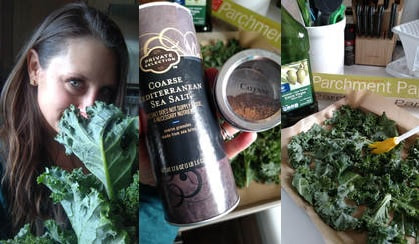
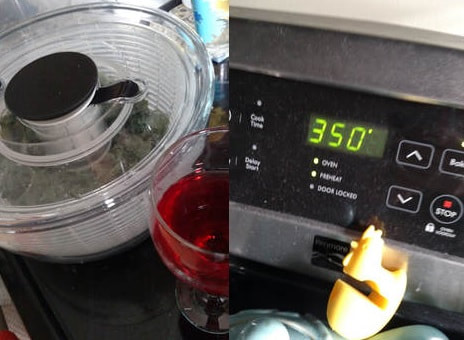
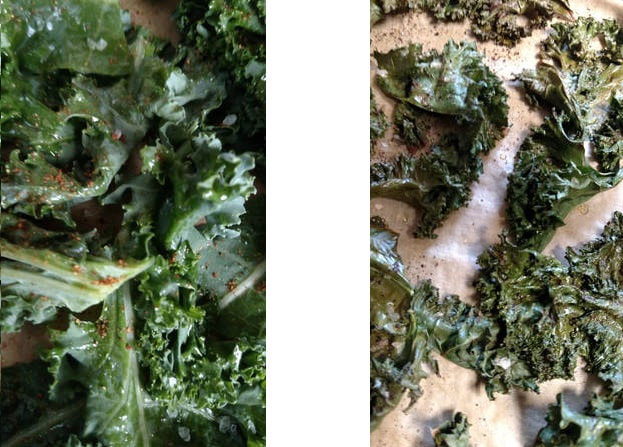
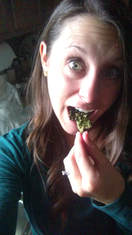
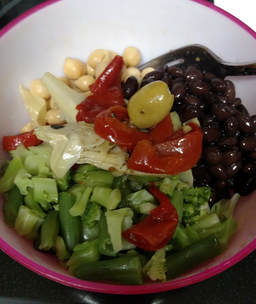
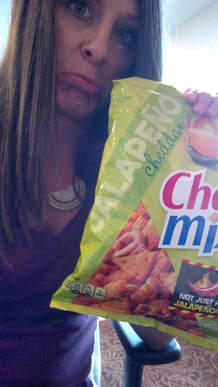

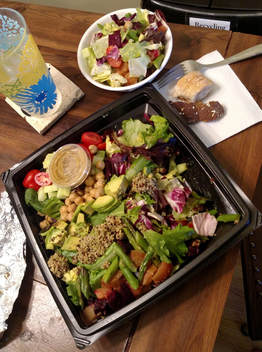
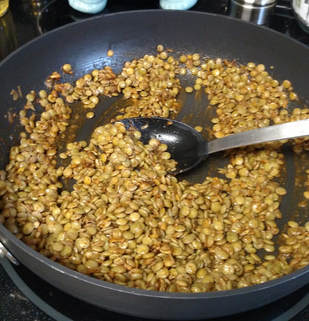
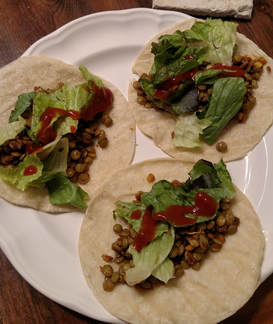
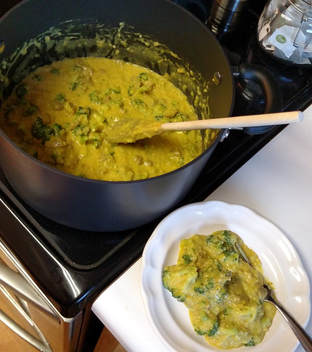
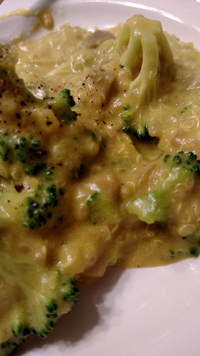
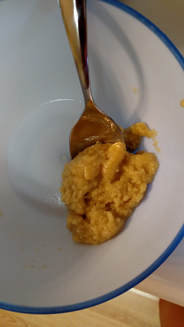
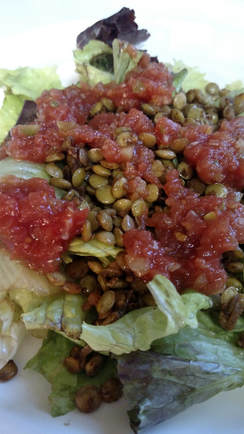
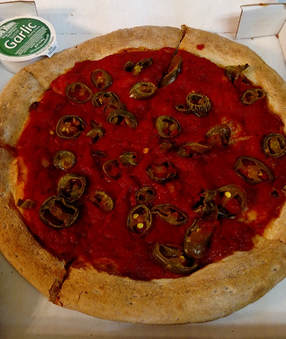
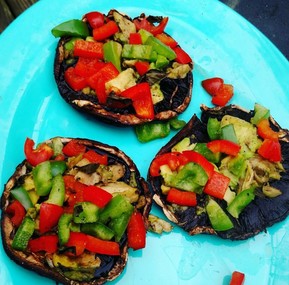
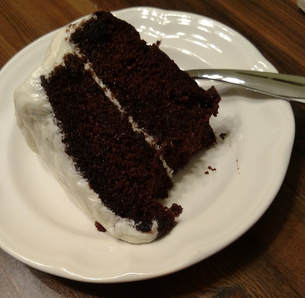
 RSS Feed
RSS Feed